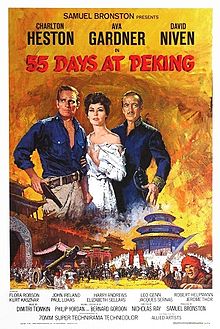| 55 Days at Peking | |
|---|---|
 | |
| Directed by | Nicholas Ray |
| Written by | |
| Produced by | Samuel Bronston |
| Starring | |
| Cinematography | Jack Hildyard |
| Edited by | Robert Lawrence |
| Music by | Dimitri Tiomkin |
Production company | Samuel Bronston Productions |
| Distributed by | Allied Artists |
Release date |
|
Running time | 153 minutes |
| Country | United States |
| Language | English |
| Budget | $10 million[1] |
| Box office | $10 million[2] |
55 Days at Peking is a 1963 American epic historical war film dramatizing the siege of the foreign legations' compounds in Beijing (then still Peking, in English) during the Boxer Uprising, which took place in China in the summer of 1900. It was produced by Samuel Bronston for Allied Artists, with a screenplay by Philip Yordan and Bernard Gordon, and with uncredited contributions from Robert Hamer, Julian Halevy, and Ben Barzman. Noel Gerson wrote a screenplay novelization in 1963 under the pseudonym "Samuel Edwards".
The film was directed primarily by Nicholas Ray, although Guy Green and Andrew Marton assumed leadership in the latter stages of filming after Ray had fallen ill. Both men were uncredited. It stars Charlton Heston, Ava Gardner, and David Niven, with supporting roles by Flora Robson, John Ireland, Leo Genn, Robert Helpmann, Harry Andrews, and Kurt Kasznar. It also contains the first known screen appearance of future martial arts film star Yuen Siu Tien. Japanese film director Juzo Itami, credited in the film as "Ichizo Itami", appears as Col. Goro Shiba.
55 Days at Peking was released by Allied Artists on May 29, 1963 and received mixed reviews, mainly for its historical inaccuracies and lack of character development. However, the film was praised for its acting, direction, music, action sequences, and production design. In addition to its mixed critical reviews, the film grossed only $10 million at the box office against a budget of $10 million. Despite this, the film was nominated for two Academy Awards. It was director Ray's last film until Lightning Over Water (1980).
- ^ "Bronston Film Two Years in Making". Los Angeles Times. May 23, 1963. Part IV, p. 10 – via Newspapers.com.
- ^ "Box Office Information for 55 Days at Peking". The Numbers. September 5, 2013.